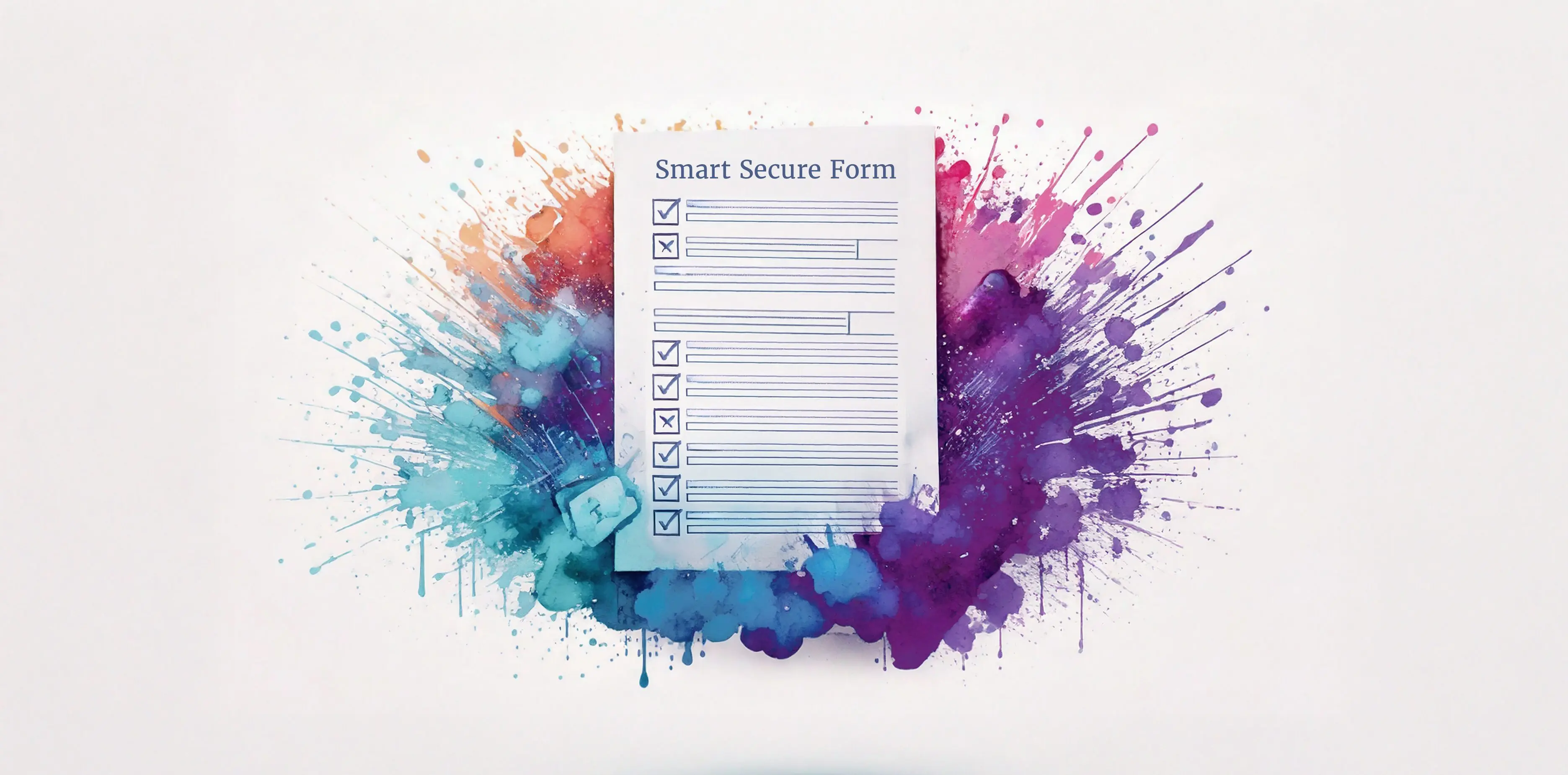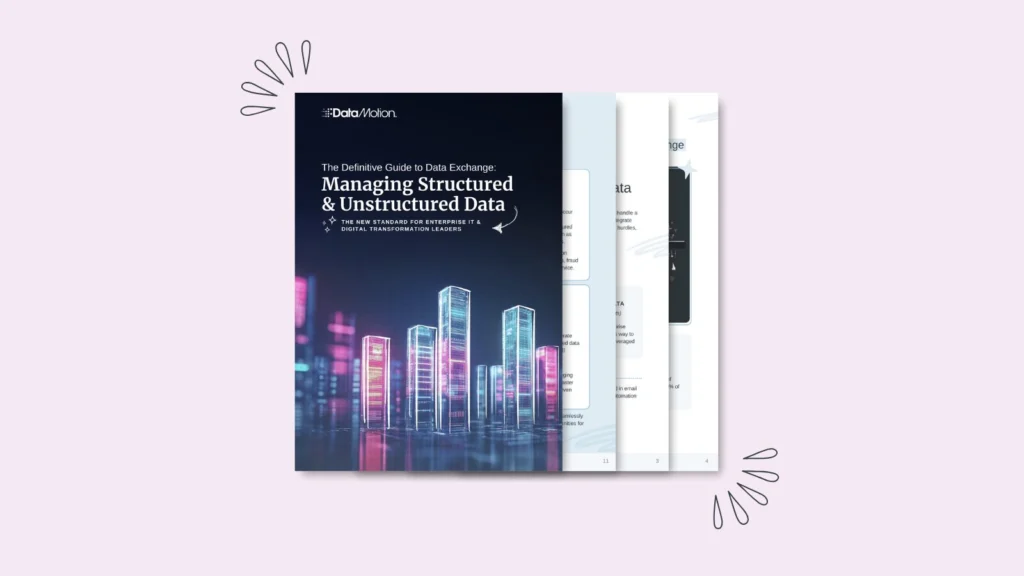Collecting sensitive data in regulated industries leaves no room for error. A single misstep, whether it’s a compliance gap, a data breach, or an operational bottleneck, can trigger regulatory fines, investigations, and lasting damage to customer trust.
IT, security, and compliance leaders are expected to enable secure data collection at speed. That means capturing sensitive information from clients, partners, and staff without disrupting established workflows, frustrating users, or exposing the business to risk.
While many enterprises default to familiar tools like Microsoft 365 or Google Workspace, these platforms were never designed for regulated data collection. As a result, teams often rely on ad hoc workarounds that don’t scale, don’t fully protect sensitive information, and often cost more in the long run.
This article explores what secure forms should deliver, where common tools fall short, and how DataMotion’s Smart Secure Forms provide a more effective, compliance-ready alternative.
What Defines a Truly Secure Form?
At its core, a secure form is an online form built to protect sensitive data at every step, from user input to when it’s stored or shared internally for review. It combines encryption in transit (TLS 1.2+) and at rest (AES 256) with strong authentication to prevent unauthorized access or loss.
For regulated industries, like finance, healthcare, insurance, and government, security is just the start. Enterprise-grade secure forms must also include role-based access control (RBAC), data residency options, audit trails, and seamless integration with existing systems. Together, these safeguards prove compliance while keeping workflows efficient.
Key requirements include:
- End-to-End Encryption (E2EE): Data should remain encrypted from the moment a user starts filling out a form to when it reaches your internal systems. That means TLS 1.2+ encryption in transit and AES-256 at rest, with no gaps in protection.
- Granular Access & Authentication: Sensitive information should only be visible to those who need it. RBAC, multi-factor authentication (MFA), and permission tiers enforce least-privilege access.
- Data Residency & Sovereignty: Organizations must control where data resides to meet HIPAA, GDPR, CCPA, and other regulatory requirements. A secure form platform should make that easy.
- Immutable Audit Trails: Every action, including form creation, submission, review, and routing, must be logged to provide verifiable proof of compliance.
These elements form the foundation for any secure online form in regulated industries. But on their own, they do not solve the broader challenges of automation, scalability, and secure collaboration. This gap becomes clear when looking at widely used tools like Google Forms and Microsoft Forms.
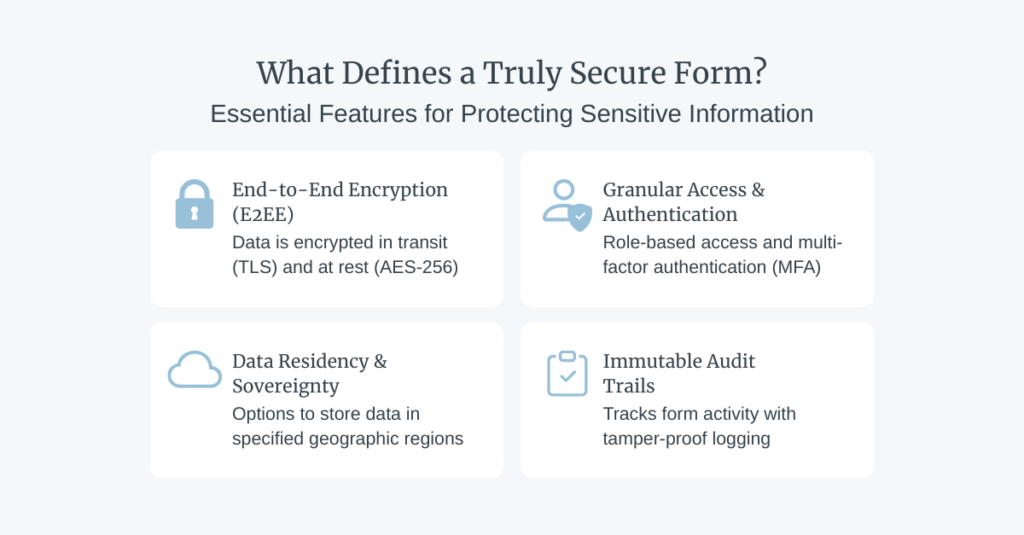
Evaluating Google & Microsoft Forms for Regulated Data
Google and Microsoft Forms are everywhere. But when it comes to regulated workflows, the question isn’t whether they can collect data — it’s whether they can protect it, govern it, and move it forward.
Organizations often turn to these tools because they are already licensed and easy to deploy. Others look to low-code tools or niche vendors to patch the gaps. For simple surveys or simple internal data collection, they can be sufficient. But for regulated industries, they lack critical safeguards and workflow capabilities.
Are Google Forms Secure?
Google Forms benefits from Google Workspace security and admin controls. But for regulated workflows, gaps appear, including limited audit depth, coarse permissions, and no native reviewer flows to manage back-and-forth corrections with submitters. Secure file collection and structured handoffs typically require add-ons or custom work. Integration paths (Sheets, Apps Script, connectors) exist, but demand effort and don’t deliver governed, bidirectional review out of the box.
As for HIPAA compliance, if you have a Google Workspace BAA and configure access, sharing, and retention correctly then Google Forms can technically be used in HIPAA-compliant environments. However, the burden sits with your team to disable public links, manage least-privilege, validate auditing, and control exports. Even when configured, native features many healthcare and financial organizations expect, like field-level review, return-for-revision, detailed audit trails, and policy-based routing, aren’t built in.
Are Microsoft Forms Secure?
Microsoft Forms aligns more naturally with enterprise environments, especially with Entra ID and Power Platform. Baseline security and administration are strong. However, like Google Forms, it isn’t built for regulated use cases. Core needs remain unmet: secure file uploads are limited, granular audit visibility is narrow, and there’s no built-in bidirectional reviewer workflow to mark fields, request fixes, and return forms securely. Deeper integrations (CRMs, EMRs, ticketing) usually rely on Power Automate flows, which add maintenance and still don’t provide governed review-and-resubmit loops inside the form experience.
The Bottom Line
Both tools are effective for lightweight use cases. Neither is designed to handle the compliance, workflow, and audit requirements of regulated industries.
Side-by-Side Comparison
Here’s how Microsoft Forms, Google Forms, and enterprise solutions like DataMotion Smart Secure Forms compare on key criteria for regulated industries:
| Feature / Capability | Microsoft Forms | Google Forms | DataMotion Smart Secure Forms |
|---|---|---|---|
| Advanced Workflow Automation | X | X | ✓ |
| Integration with CRMs, EMRs, Compliance Tools | ◯ (via Power Automate) | X | ✓ |
| Auditability and Logging | ◯ (Limited) | X | ✓ |
| Data Residency Controls | ◯ (Azure-based) | ◯ (US/EU options via admin tools) | ✓ |
| AI Enablement / Policy-Based Routing | X | X | ✓ |
| Zero-Trust Alignment | ◯ (Entra ID support) | X | ✓ |
| Structured Data for Downstream Systems | X | X | ✓ |
| Bidirectional Exchange & Reviewer Workflows | X | X | ✓ |
Moving Beyond One-Way Forms
What happens when a customer submits the wrong information on a loan application? In most tools, the process stalls. Smart Secure Forms keep the workflow alive — securely, and without losing momentum.
Traditional forms are static. Data goes in, then the process halts until someone manually reviews it. In regulated workflows, that model adds friction, increases error rates, and slows down processes like onboarding, claims, or compliance reporting.
Smart Secure Forms take a different approach. They go beyond encryption alone by combining compliance-grade security with workflow intelligence. A Smart Secure Form is designed not only to protect sensitive data but also to enable secure, structured, repeatable, and auditable exchanges between submitters and reviewers, supporting bidirectional collaboration and seamless integration into the enterprise systems your teams already use.
This is the true differentiator. Most form tools are one-way streets, forcing teams to scramble with emails or phone calls when something goes wrong. Smart Secure Forms are built to complete workflows, not just initiate them. And with each exchange, momentum builds, a flywheel effect that reduces friction, strengthens compliance, and drives adoption across the enterprise.
Smart Secure Forms in Action
AI That Accelerates Form Creation
With JenAI Create, organizations can generate forms from existing PDFs or natural language instructions in minutes. This reduces IT backlog, speeds deployment, and ensures every form, including AI-generated or manually built, adheres to the same compliance and security standards.
Bidirectional Exchange That Keeps Workflows Moving
Instead of dead-end submissions, Smart Secure Forms enable secure back-and-forth exchanges. Confirmation messages, ticket numbers, correction requests, and reviewer feedback are all handled within the same governed environment. The result: fewer abandoned workflows and faster completion.
Consider these real-world use cases:
- Customer Onboarding: A new client submits identification and account details. Instead of waiting days, they receive a secure confirmation and ticket number instantly. If documentation is incomplete, the form is returned with a flagged field for quick correction; no restart required.
- Claims Processing: An insurance adjuster reviewing a submitted claim securely sends it back for clarification on one field. The customer corrects it within minutes, avoiding costly delays while maintaining compliance.
- Employee Onboarding: HR teams collect sensitive data like tax forms and benefit elections. If a field is missing, HR can request it securely inside the same workflow. This ensures compliance while keeping the employee experience smooth.
- Customer Service Requests: A customer submits a secure service inquiry through a portal. The service team responds with a ticket number and next steps — all contained within the secure environment, reducing follow-up calls and frustration.
These examples represent just a few of the workflows where Smart Secure Forms transform static intake into secure, dynamic collaboration, turning what used to be bottlenecks into streamlined, compliant, end-to-end processes.
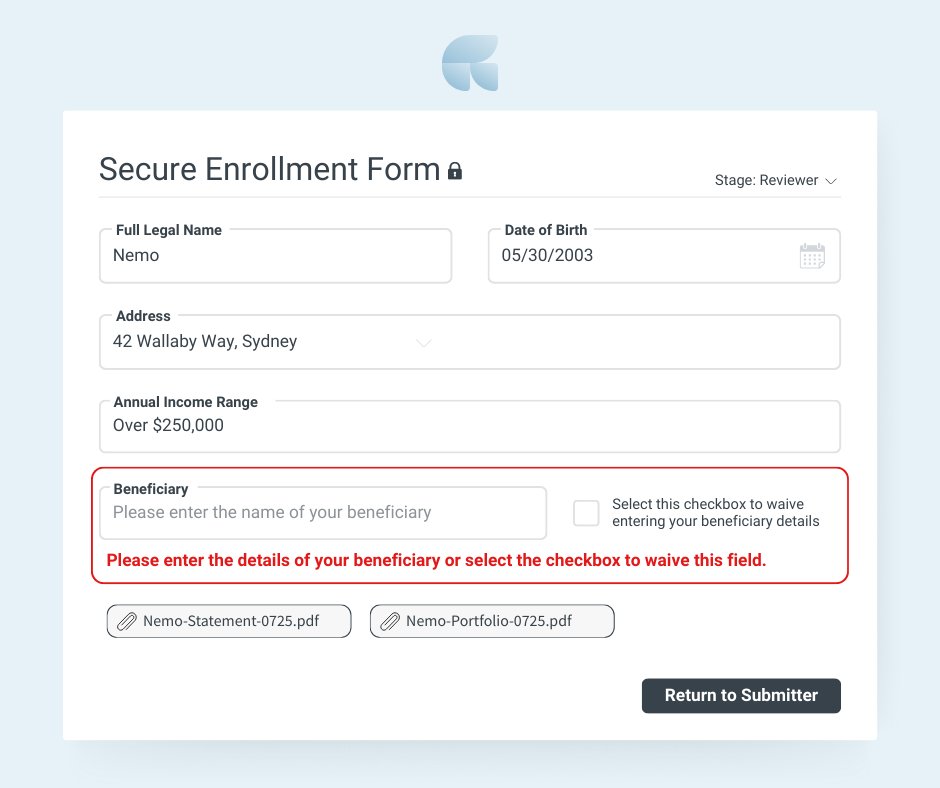
Compliance That Scales
Every form includes built-in protections including end-to-end encryption, RBAC, data residency controls, and comprehensive audit logging. HITRUST CSF® Certification provides independent assurance that compliance requirements are met.
Seamless Integration with Enterprise Systems
Submissions flow directly into the systems employees already use, like Salesforce, EMRs, SharePoint, and ticketing tools, triggering downstream processes automatically. This minimizes manual handoffs and reduces the risk of human error.
Structured Data for Insight and Action
Every submission is converted into structured data, ready for dashboards, compliance reporting, or advanced analytics in AI tools like Microsoft Fabric. What was once “dark data” becomes a valuable source of insight.
Optimized for the Microsoft Ecosystem
Native integration with Microsoft 365, Entra ID, and Azure simplifies rollout and administration. DataMotion’s eligibility for Azure Marketplace procurement further accelerates adoption.
Frictionless User Experience
Smart Secure Forms embed directly into portals, secure emails, or applications. They require no additional logins and deliver a consistent, responsive experience across devices, ensuring high adoption and low user resistance.
Streamlined Migration from Legacy Tools
Organizations can replicate existing workflows in Smart Secure Forms, enabling smooth transitions from outdated or non-compliant tools without retraining staff or rebuilding logic from scratch.
A Framework for Evaluation
Not all secure forms are created equal. Lightweight tools may encrypt data, but they rarely address the governance, compliance, and workflow realities of regulated industries.
When evaluating platforms, enterprises should move beyond basic security checkboxes and ask questions that reveal whether a solution is truly built for regulated workflows:
Security & Compliance
- Which certifications (e.g., HITRUST CSF®) validate the platform’s security?
- How is data residency enforced?
- What tools support compliance management at scale?
Integration & Workflow
- Does the solution provide native connectors or APIs?
- Can it support multi-stage review and escalation workflows?
- Does the form integrate with our existing CRM or EMR?
- How does it handle real-time routing and enrichment?
Implementation & Support
- What onboarding processes are available for enterprises?
- What level of ongoing support is included?
Total Cost of Ownership
- How does the solution reduce costs related to compliance management, data entry, or tool sprawl?
- Is pricing aligned with usage, users, or outcomes?
This framework helps IT, compliance, and security leaders separate lightweight form tools from true enterprise-grade solutions.
Security is the Foundation, Intelligence is the Future
Security alone is no longer a differentiator; in regulated industries, it’s the baseline. What sets today’s leaders apart is intelligence; forms that not only protect data but also drive workflows, automate compliance, and deliver insight at scale.
DataMotion Smart Secure Forms were designed with these requirements in mind. They combine compliance-grade security with automation, AI, and native Microsoft ecosystem integration. The result? Forms that reduce risk, accelerate onboarding and claims workflows, streamline compliance reporting, and improve customer experiences.
With Smart Secure Forms, regulated industries move beyond one-way intake to a model that unites data, security, and action in a single, frictionless step.
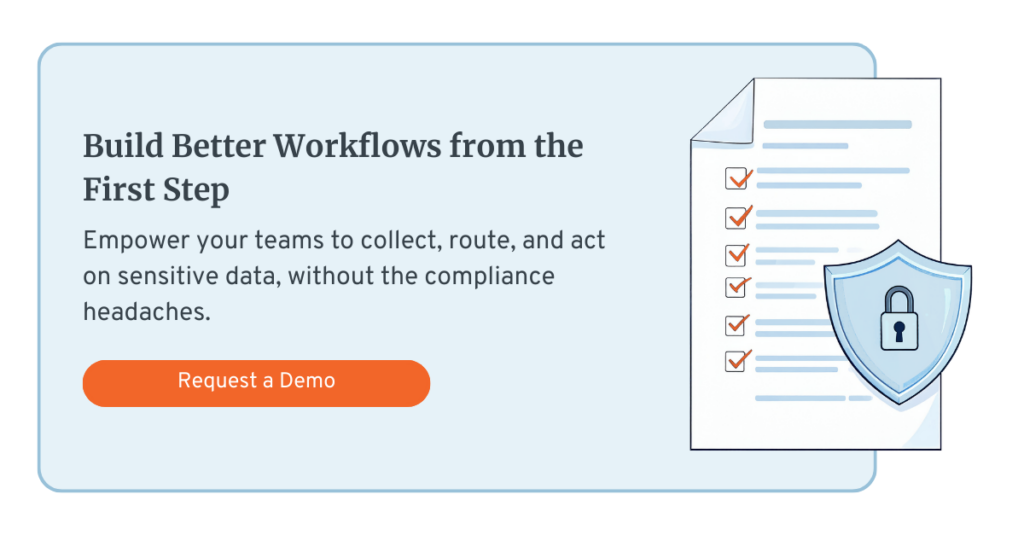
Frequently Asked Questions
How do secure forms improve data collection processes?
Secure forms protect sensitive information, but the right solution also improves how data is collected and used. Features like field-level validation, conditional logic, and automated routing reduce manual errors and delays. This helps teams get clean, complete submissions faster, without needing follow-up emails or rework.
Are all secure forms equally efficient for data collection?
Not quite. Some tools simply encrypt the form while others help you act on the data. Enterprise-grade platforms like Smart Secure Forms include workflow automation, reviewer feedback loops, and analytics. That means fewer bottlenecks, faster reviews, and better integration with downstream systems.
How do Smart Secure Forms help with compliance?
They do more than just check the security box. Smart Secure Forms combine encryption, audit trails, access controls, and data residency options to help teams meet HIPAA, GDPR, and other regulatory standards. And because workflows are embedded and traceable, they reduce the risk of human error or policy violations.
Can secure forms replace traditional intake tools like PDFs or email attachments?
Yes, and they should. Paper and email-based forms slow down intake, introduce errors, and create audit gaps. With AI-powered form creation (like JenAI Create), teams can digitize legacy forms in minutes and move to a secure, trackable process that’s easier for both staff and customers.
